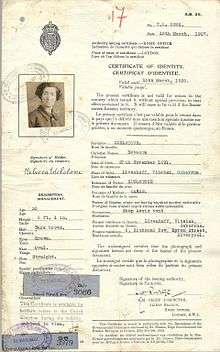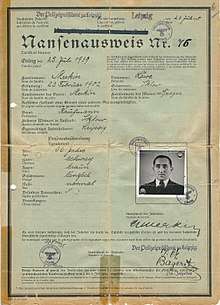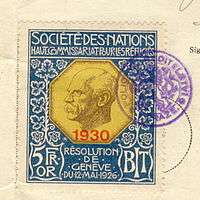Nansen passport
| Nansen passport | |
|---|---|
 The front cover of a Nansen passport (green stripe) | |
| Date first issued | 1922 |
| Issued by | League of Nations |
| Type of document | Passport |
| Purpose | Identification |
| Eligibility requirements | Stateless refugees |
| Expiration | 1938 |
Nansen passports, originally and officially stateless persons passports, were internationally recognized refugee travel documents from 1922 to 1938, first issued by the League of Nations to stateless refugees.[1] They quickly became known as "Nansen passports" for their promoter, the statesman and polar explorer Fridtjof Nansen.
History
The end of World War I saw significant turmoil, leading to a refugee crisis. Numerous governments were toppled, and national borders were re-drawn, often along generally ethnic lines. Civil war broke out in some countries. Many people left their homes because of war or persecution or fear thereof. The upheaval resulted in many people's being without passports, or even nations to issue them, which prevented much international travel. The first Nansen passports were issued following an international agreement reached at the Intergovernmental Conference on Identity Certificates for Russian Refugees, convened by Fridtjof Nansen in Geneva from July 3, 1922, to July 5, 1922,[2] in his role as High Commissioner for Refugees for the League of Nations.[3] By 1942, they were honoured by governments in 52 countries. Approximately 450,000 Nansen passports were provided[4] to stateless people and refugees who needed travel documents but could not obtain one from a national authority.
The Nansen passport was originally provided to refugees from the Russian civil war. It is estimated that about 800,000 Russian refugees had become stateless when Lenin revoked citizenship for all Russian expatriates in 1921.[5] In 1933, the arrangement was broadened to also include Armenian, Assyrian, and Turkish refugees.[6]
Following Nansen's death in 1930, the passport was handled by the Nansen International Office for Refugees within the League of Nations. At that point the passport no longer included a reference to the 1922 conference, but were issued in the name of the League. The office was closed in 1938; passports were thereafter issued by a new agency, the Office of the High Commissioner for Refugees under the Protection of the League of Nations in London.[7][8]


Image gallery
 Nansen passport cover,
Nansen passport cover,
Police office, Prague, 1930 Nansen passport renewal stamp,
Nansen passport renewal stamp,
Nansen International Office for Refugees- Memorial Plaque (partial view),
outside wall,
City Hall, Oslo, Norway
Legacy
The Nansen International Office for Refugees was awarded the 1938 Nobel Peace Prize for its efforts to establish the Nansen passports.[9][10]
While Nansen passports are no longer issued, existing national and supranational authorities, including the United Nations, issue travel documents for stateless people and refugees, including certificates of identity (or "alien's passports") and refugee travel documents.
Notable holders
- Robert Capa
- Princess Vera Constantinovna of Russia
- Marc Chagall[11][12]
- Françoise Frenkel
- Alexander Galich
- Zuzanna Ginczanka
- Alexander Grothendieck[13]
- G. I. Gurdjieff
- Anatol Heintz[11][12]
- Vladimir Nabokov
- Aristotle Onassis
- Krikor Pambuccian
- Anna Pavlova[11][12]
- Grand Duchess Maria Pavlovna of Russia (1890–1958)
- Jadwiga Piłsudska
- Sergey Rakhmaninov[11][12]
- Dimitri Riabouchinsky
- Rabbi Menachem Mendel Schneerson
- Igor Stravinsky[12][11]
- Dries Riphagen
References
- ↑ "The Little-Known Passport That Protected 450,000 Refugees" Atlas Obscura, Retrieved October 10, 2017
- ↑ Refugees, United Nations High Commissioner for. "Refworld - Arrangement with respect to the issue of certificates of identity to Russian Refugees". refworld.org. Retrieved April 9, 2018.
- ↑ "Documents from the League of Nations Archives" (PDF). Refugee Survey Quarterly. 22 (1): 71–73. 2003. doi:10.1093/rsq/22.1.71. Retrieved June 25, 2014.
- ↑ Nansen-pass Store Norske Leksikon, retrieved December 11, 2012
- ↑ Nansen the humanist, retrieved December 11, 2012
- ↑ "Arrangement of 12 May 1926 relating to the Issue of Identity Certificates to Russian and Armenian Refugees League of Nations, Treaty Series Vol. LXXXIX, No. 2004" (PDF). refworld.org. Retrieved April 9, 2018.
- ↑ "Office of the High Commissioner for Refugees under the Protection of the League - Yearbook Profile - Union of International Associations". www.uia.org. Retrieved April 9, 2018.
- ↑ The Nansen Office Arkivverket. Retrieved December 2, 2014
- ↑ Fridtjof Nansen, Nobelprize.org, 1922. Retrieved February 22, 2011.
- ↑ "The Nansen International Office for Refugees - Nobel Lecture". www.nobelprize.org. Retrieved April 9, 2018.
- 1 2 3 4 5 The Nansen Office Arkivverket.no, retrieved December 11, 2012
- 1 2 3 4 5 Nansenkontoret Arkivverket.no (in Norwegian), retrieved December 11, 2012
- ↑ Mumford, David (2015). "(Obituary) Alexander Grothendieck (1928–2014) Mathematician who rebuilt algebraic geometry". Retrieved 2015-10-14.
External links
- Fridtjof Nansen Memorial Lecture Series United Nations University
- The Nansen Passport New York University Department of Media, Culture, and Communication's Media Archaeology's Dead Media Archive